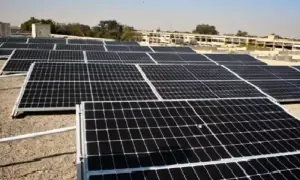A 'non-serious' budget
 -File Photo
-File PhotoNow that the federal budget 2016-17, the fourth budget of the currentgovernment is likely to be approved soon by the Parliament, I would like to warn the readers and those who have interest in Pakistan's economy that this is a highly fragile and non-serious budget, with serious macroeconomic consequences for the economy.
It hides many facts than it reveals the true intention of the government.
Pakistan is technically still under the IMF Programme, therefore, it has to meet the budget deficit target as agreed with the IMF. But at the same time, the government wants to dole out resources as it appears that it has entered the election campaign mode.
This budget has attempted to strike a balance in an ingenious way between meeting the IMF conditionality on the one hand and doling out resources as part of the election campaign on the other.
What the government has revealed in the budget is something that was required to keep the IMF happy, that is, meeting the deficit target (3.8% of GDP or Rs 1276 billion), at least on paper. This is what matters for the IMF. What it has not revealed in the budget is the resources which have been doled out as part of the election campaign.
In this article, I highlight that part of the budget which has not been revealed by the government. It has grossly overstated the revenue, massively understated expenditure, did not take into account the loss of revenue as a result of taxation measures, and grossly overestimated the provincial surpluses.
This article also highlights the risks attached with external resource inflows.
On the understatement of expenditure, the government, in order to pacify the farmers, has announced several measures to revive the sector.
This included, among others, the subsidy on fertiliser to the extent of Rs 46 billion with federal government footing 50 percent of the bill, that is, Rs 23 billion.
Similarly, the government announced the subsidy of Rs 27 billion on account of reduction in electricity tariff for agriculture tube wells.The total subsidy therefore amounts to Rs 50 billion which is missing from the budget document.
The government has announced an extensive pay and pensions relief amounting Rs 57 billion (see para 116 of the Budget Speech) which is again missing from the budget document. Interest payment, the single largest budgetary item, is grossly understated.
Given the maturity of high cost Pakistan Investment Bonds (PIBs) in the domestic sources and high cost borrowing from external sources, interest payment is understated to the extent of Rs 100 billion. Expenditure, therefore, is understated to the extent of Rs 207 billion.
On the overstatement of revenue, the government has included Rs 170.7 billion or $1.6 billion Coalition Support Fund (CSF) under the non-tax revenue.
The United States Senate has recently passed its draft of the National Defence Authorisation Bill, which includes $800 million or Rs 85.3 billion under Pakistan Security Enhancement Authorization. This amount is one-half of the budgeted amount, therefore, a sum of Rs 85.3 billion is overstated in revenue.
Given the current state of bilateral relations between the two countries, there is a risk involved even in this limited inflows.
The government has kept Rs 75 billion under PTA (4G licenses), appearing as non-tax revenue. It has just sold one license to a single bidder amounting $395 million or Rs 42 billion.
Is there any appetite for yet another 4G license? Is the single bidder who just bought one license and paid only one-half of the amount, expected to buy another one in 2016-17?
Is the spectrum available for sale in 2016-17? The answer to these queries are in negative, therefore, this amount is not likely to be available in 2016-17.
The government has announced that all pending sales tax refunds till April 30 whose papers have been completed, will be cleared by August 31, 2016 amounting Rs 100 billion for which, no provision is made in the budget.
In other words tax revenue for the year 2016-17 will be down by Rs 100 billion. Thus, altogether Rs 346 billion revenue is overstated in the Budget 2016-17.
The government has taken various taxation measures in the budget 2016-17. These measures will result in loss of revenue as well as gains in revenue with resulting net loss to revenue.
The government has reduced corporate tax rate by 1.0 percent, reduced customs tariff slabs from 5 to 4, reduced GST rate on POL productsand fertiliser and zero-rated five export sectors. The total loss in revenue is calculated to be Rs 200 billion.
But at the same time, the government has imposed withholding tax on property and others, it has imposed federal excise duty on cement at the rate of Rs 1.0/kg, and savings from input adjustment in GST.
These measures will yield Rs 100 billion to government. The net loss to revenue as a result of tax measures is estimated at Rs 100 billion.
Provincial PSDP amounting Rs 875 billion was approved by the National Economic Council for the year 2016-17. The budgets of all the provinces have been presented to their respective assemblies.
The total provincial PSDP is now estimated to be Rs 1042 billion - an overshooting of Rs 167 billion. Such overshooting will have implications for the budgeted provincial surplus.
This leads to the discussion on provincial surplus. In order to achieve the budget deficit target of 3.8 percent of GDP in 2016-17, the government has assumed that the provinces will deliver a combined surplus of Rs 339 billion in their budgets.
Should we expect such a large surplus from provinces whose development spending have already exceeded the target by Rs 167 billion; provinces are expected to share subsidy on fertiliser to the extent of Rs 23 billion, and that they have to raise pay and pensions of their employees costing Rs 100 billion.
Hence, the loss to provincial surplus is estimated to be Rs 290 billion, that is, the government is not likely to receive provincial surplus amounting Rs 339 billion. In fact, the government may expect only Rs 49 billion.
Based on the above analysis, the total slippages in the budget is amounted to Rs 857 billion or 2.6 percent of GDP. Overall fiscal deficit is, therefore, estimated to be Rs 2133 billion (Rs 1276 billion + Rs 857 billion) or 6.4 percent of GDP in 2016-17.
If we add circular debt to make the deficit consistent with 2012-13, the overall fiscal deficit may reach over 8.2 percent of GDP. This level of fiscal deficit is consistent with that of last five years, that is, 2012-13 onward.
How the government is going to finance sucha large gap in the budget? The government is expected to finance fiscal deficit through both external and domestic sources.
As shown in the budget document, there are serious risks associated with external flows. Both the multilateral development institutions (World Bank and the ADB) as well as the Islamic Development Bank (IDB) have significantly scaled down their lending to Pakistan.
Even our best friend China has withdrawn its $1.0 billion under China Safe Deposit from the State Bank of Pakistan (interestingly, this withdrawal of $1.0 billion did not impact our foreign exchange reserves. Can the SBP explain this?).
Such scaling down of external flows has forced the government to rely more on non-traditional sources of external flows like borrowing from foreign commercial banks ($2 billion or Rs 211.5 billion) and floating Eurobond and Sukuk (Islamic bond) amounting $1.75 billion or Rs 184.6 billion.
Thus, out of Rs 797 billion estimated external inflows, one-half (Rs 396 billion) is expected to come from foreign commercial banks borrowing and through floatation of various sovereign bonds.
Can Pakistan attract investors in sovereign bond floatation when it is out of the IMF program and multilateral development financial institutions have scaled down their lending? Hence, financing such a large fiscal deficit (Rs 2133 billion) in a highly risky external flows environment will be a serious challenge for the government.
Accordingly, the government's reliance on domestic sources, particularly local commercial banks to finance fiscal deficit would be extremely high, leading to massive crowding out of private sector.
The macroeconomic consequences of such a risky budget include: (i) massive crowding out as bulk of the commercial banks' lending would be siphoned out by the government, (ii) it would certainly increase money supply with serious consequences for a surge in inflation, and (iii) targeting a growth rate of 5.7 percent in 2016-17 in the midst of massive crowding out would be contradictory to each other.
Thus, based on the above argument, it is safe to suggest that the federal budget 2016-17 is a non-serious budget. It hides more facts than it reveals and hence will have serious macroeconomic consequences for the economy.
=======================================================================
Details of Slippages
=======================================================================
Overstatement of Revenue = Rs 260.3 billion
=======================================================================
a) Rs 85.3 billion from CSF (Non - Tax Revenue)
b) Rs 75 billion from PTA (4G License: NTR)
c) Rs 100 billion refund out of tax collection
d) Net Impact of Taxation
Loss in Revenue: = Rs 200 billion
(d1) Reduction in corporate tax rate by 1.0% = Rs 20 billion
(d2) Customs tariff slabs are being
reduced from 5 to 4. As a result of the
reduction one slab, the loss in revenue is Rs 30 billion
(d3) Reduction of GST rate on POL products = Rs 100 billion
(d4) GST rate on fertiliser reduced to 5% = Rs 15 billion
(d5) Zero rating of five export sectors
textile, leather, sports goods, surgical
goods, and carpets) = Rs 30 billion
Total Loss of Revenue (d1 to d5) = Rs 195 billion
or Rs 200 billion
Gain in Revenue = Rs 100 billion
(d6) Withholding tax on property and others = Rs 25 billion
(d7) Saving from input adjustment = Rs 50 billion
(d8) Federal Excise duty on cement @ Rs 1.0/kg = Rs 25 billion
-----------------------------------------------------------------------
Total Gains in Revenue (d6 to d8) = Rs 100 billion
-----------------------------------------------------------------------
Provincial PSDP approved by the NEC = Rs 875 billion
-----------------------------------------------------------------------
Actual Provincial PSDP
-----------------------------------------------------------------------
- Punjab = Rs 550 billion
- Sindh = Rs 260 billion
- KPK = Rs 161 billion
- Balochistan = Rs 71.0 billion
-----------------------------------------------------------------------
Total = Rs 1042 billion
-----------------------------------------------------------------------
Overshooting of Provincial PSDP = Rs 167 billion
Likely Slippage from Provincial Surpluses = Rs 290 billion
- Overshooting of Provincial PSDP = Rs 167 billion
- Sharing of Fertiliser Subsidy = Rs 23 billion
- Overshooting of Pay & Pension = Rs 100 billion
-----------------------------------------------------------------------
Summary
-----------------------------------------------------------------------
A. Overstatement of Revenue
-----------------------------------------------------------------------
- Inclusion of Coalition Support Fund = Rs 85.3 billion
- Inclusion of PTA (4G License) auction = Rs 75.0 billion
- Refund of Taxation = Rs 100.0 billion
Rs 260.3 billion
B. Net Loss to Revenue as a result
of taxation measures = Rs 100 billion
C. Understatement of Expenditure
- Subsidy on Fertiliser and Tubewell = Rs 50 billion
- Pay and Pension = Rs 57 billion
- Interest Payment = Rs 100 billion
Rs 207 billion
D. Loss in Provincial Surpluses
Overshooting of Provincial PSDP = Rs 167 billion
Sharing of Fertiliser Subsidy = Rs 23 billion
Overshooting as a result of Pay & Pension = Rs 100 billion
Rs 290 billion
-----------------------------------------------------------------------
Total Slippages (A+B+C+D) = Rs 857 billion
-----------------------------------------------------------------------
Targeted budget deficit = Rs 1276 billion
or 3.8 % of GDP
or 2.6% of GDP
Likely Fiscal Deficit in 2016-17 = Rs 2133 billion
or 6.4% of GDP
-----------------------------------------------------------------------
If we add circular debt, budget deficit may reach over 8.2% of GDP
-----------------------------------------------------------------------
(The writer is Principal & Dean at NUST School of Social Sciences & Humanities, Islamabad and former Economic Advisor to Ministry of Finance, Government of Pakistan)
=======================================================================



















Comments are closed on this story.